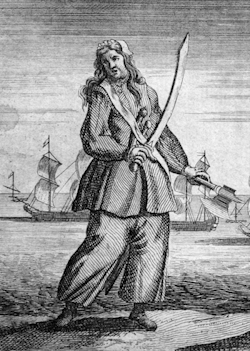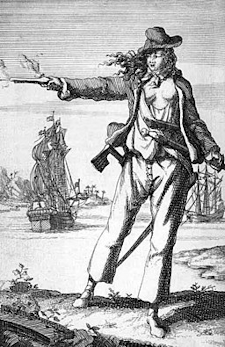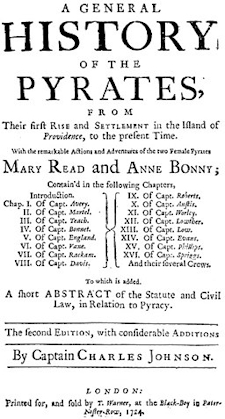“She was of a fierce and courageous Temper, wherefore, when she lay under Condemnation, several Stories were reported of her, much to her disadvantage, …” Captain Johnson, A General History of the Pyrates, 1724
 Ann Bonny, her first name sometimes spelt Anne, was one of the two notorious female pirates who sailed with Jack Rackham. Much has been written, but no so much is really known about her life. It is unclear where she really came from. It is often claimed she was born in Ireland, but there is no evidence of this, although it can be assumed she was born sometime in the late 1690s. No primary source, including her own trial transcript, makes mention of her age or nation of origin. No records of an Ann Bonny being born in the late 17th century have been found in the list of baptisms of Ireland. Bonny is not noted as having been an inhabitant of Nassau before pirates arrived in 1713. Prior to 22 August 1720, little can be definitively said about Bonny’s life. Interestingly, an Ann Bonny is recorded as being born in London on 19th October 1690, but it can’t be proved that this was the one who later became a pirate. Although she is closely associated with Jack Rackham, little is known about extent of their relationship, as there were no descriptions of this in contemporary documents. Bonny is never documented as participating in an actual fight or disguising herself as a man, except during engagements. She first appears on a proclamation by Woodes Rogers in The Boston Gazette in August 1720.
Ann Bonny, her first name sometimes spelt Anne, was one of the two notorious female pirates who sailed with Jack Rackham. Much has been written, but no so much is really known about her life. It is unclear where she really came from. It is often claimed she was born in Ireland, but there is no evidence of this, although it can be assumed she was born sometime in the late 1690s. No primary source, including her own trial transcript, makes mention of her age or nation of origin. No records of an Ann Bonny being born in the late 17th century have been found in the list of baptisms of Ireland. Bonny is not noted as having been an inhabitant of Nassau before pirates arrived in 1713. Prior to 22 August 1720, little can be definitively said about Bonny’s life. Interestingly, an Ann Bonny is recorded as being born in London on 19th October 1690, but it can’t be proved that this was the one who later became a pirate. Although she is closely associated with Jack Rackham, little is known about extent of their relationship, as there were no descriptions of this in contemporary documents. Bonny is never documented as participating in an actual fight or disguising herself as a man, except during engagements. She first appears on a proclamation by Woodes Rogers in The Boston Gazette in August 1720.
The legends surrounding Ann Bonny
 Captain Charles Johnson created an intriguing backstory for Bonny in his notorious book A General History of the Pyrates first published in 1724. At the time, the public was fascinated by women who went against the accepted conventions of the time and books like Daniel Defoe’s Moll Flanders publish in 1722 were extremely popular, as were real life stories like that of Christian Davies, a woman who joined the English army disguised as a man in 1693 and fought in the Spanish War of Succession. Johnson claims that Bonny’s father was a lawyer living near Cork in Ireland and her mother a Maid called Mary, with whom he had an affair. One theory on who Ann’s parents were that was previously put forward was that she was born in Ireland to William Cormac and Mary Brennan in 1700, but the source used has since been discredited. They turned out to be fictional names first written down in the 1964 romance novel Mistress of the Seas by John Carlova. Johnson writes that the affair between Bonny’s father and the maid was discovered after a dramatic incident involving missing silver spoons, resulting in the arrest of Mary. She was released from jail on lack of evidence, but found to be pregnant, later giving birth to Ann Bonny. To avoid scandal, the unnamed lawyer left Ireland with the maid, whom he had married, and emigrated to America with her and the child, where he purportedly became a merchant and plantation owner in South Carolina. Johnson describes Ann as being of “fierce and courageous temper.” She is said to have stabbed a servant girl to death in a fit of rage and severely beaten a man for attempting to rape her. In volume 2 of A General History published in 1728, she ran away with a penniless sailor called James Bonny against her father’s wishes, taking her husband’s name as her own, ending up in New Providence, where she met Rackham and later joined him in piracy.
Captain Charles Johnson created an intriguing backstory for Bonny in his notorious book A General History of the Pyrates first published in 1724. At the time, the public was fascinated by women who went against the accepted conventions of the time and books like Daniel Defoe’s Moll Flanders publish in 1722 were extremely popular, as were real life stories like that of Christian Davies, a woman who joined the English army disguised as a man in 1693 and fought in the Spanish War of Succession. Johnson claims that Bonny’s father was a lawyer living near Cork in Ireland and her mother a Maid called Mary, with whom he had an affair. One theory on who Ann’s parents were that was previously put forward was that she was born in Ireland to William Cormac and Mary Brennan in 1700, but the source used has since been discredited. They turned out to be fictional names first written down in the 1964 romance novel Mistress of the Seas by John Carlova. Johnson writes that the affair between Bonny’s father and the maid was discovered after a dramatic incident involving missing silver spoons, resulting in the arrest of Mary. She was released from jail on lack of evidence, but found to be pregnant, later giving birth to Ann Bonny. To avoid scandal, the unnamed lawyer left Ireland with the maid, whom he had married, and emigrated to America with her and the child, where he purportedly became a merchant and plantation owner in South Carolina. Johnson describes Ann as being of “fierce and courageous temper.” She is said to have stabbed a servant girl to death in a fit of rage and severely beaten a man for attempting to rape her. In volume 2 of A General History published in 1728, she ran away with a penniless sailor called James Bonny against her father’s wishes, taking her husband’s name as her own, ending up in New Providence, where she met Rackham and later joined him in piracy.
 Ann bonny is said to have given birth to a child on Cuba before returning to sea. This unlikely story is not mentioned at all the 1728 volume of A General History, which goes into a little more detail about Bony and Rackham’s relationship. In this volume it is claimed that Bonny wanted to divorce James Bonny and marry Rackham, but Governor Rogers was so outraged by this he threatened to have Bonny whipped, so the two lovers fled on a stolen sloop called the William. James Bonny is said to have taken the King’s pardon, but there is no record of this in Captain Vincent Pearse’s list of pardoned pirates. There are even claims he might not have ever existed. A General History claims Bonny eventually fell in love with another pirate on board, only to discover it was Mary Read. Rackham suspected a romantic involvement between the two, so to abate his jealousy Bonny revealed to him that Read was really a woman and swore him to secrecy. This is unlikely, since Rogers’ 1720 proclamation names both women openly, so they must have been both already known to him by that time. It has been claimed that Bonny and Read revealed there breasts when capturing a ship to distract their opponent and let them know they had been defeated by a woman. There is no evidence of this, as they never had to take a ship by force, and later images that depicted the women exposing the bosom were probably only the artists way of emphasising they were female. When they were captured,Johnson writes that only Ann Bonny, Mary Read, and one other shipmate fought to defend the ship while the others all retreated below deck after asking for quarter. Bonny and Read allegedly called them cowards and fired their pistols into the hold, killing one and wounding others, but this is not mentioned in any of the trial documents and there weren’t any recorded casualties during the capture of Rackham’s ship.
Ann bonny is said to have given birth to a child on Cuba before returning to sea. This unlikely story is not mentioned at all the 1728 volume of A General History, which goes into a little more detail about Bony and Rackham’s relationship. In this volume it is claimed that Bonny wanted to divorce James Bonny and marry Rackham, but Governor Rogers was so outraged by this he threatened to have Bonny whipped, so the two lovers fled on a stolen sloop called the William. James Bonny is said to have taken the King’s pardon, but there is no record of this in Captain Vincent Pearse’s list of pardoned pirates. There are even claims he might not have ever existed. A General History claims Bonny eventually fell in love with another pirate on board, only to discover it was Mary Read. Rackham suspected a romantic involvement between the two, so to abate his jealousy Bonny revealed to him that Read was really a woman and swore him to secrecy. This is unlikely, since Rogers’ 1720 proclamation names both women openly, so they must have been both already known to him by that time. It has been claimed that Bonny and Read revealed there breasts when capturing a ship to distract their opponent and let them know they had been defeated by a woman. There is no evidence of this, as they never had to take a ship by force, and later images that depicted the women exposing the bosom were probably only the artists way of emphasising they were female. When they were captured,Johnson writes that only Ann Bonny, Mary Read, and one other shipmate fought to defend the ship while the others all retreated below deck after asking for quarter. Bonny and Read allegedly called them cowards and fired their pistols into the hold, killing one and wounding others, but this is not mentioned in any of the trial documents and there weren’t any recorded casualties during the capture of Rackham’s ship.
Ann Bonny’s actual pirating career
It is thought Ann Bonny arrived in Nassau at some time between 1715 and 1717. At this time most of the women there were either the wives of pirates or were prostitutes. Bonny might have indeed been married to a pirate if the story of her wanting a divorce in volume 2 of A General History is to be believed. She most certainly met some of the other well-known pirates such as Blackbeard, Benjamin Hornigold, and Sam Bellamy while she lived in Nassau. All we know of her relationship with Rackham is that they met on New Providence and that she was pregnant when arrested in October 1720. We can assume that he was the father, although we cannot say for certain. In August 1720, she stole the sloop William together with Rackham and Mary Read, later participating in the capture of several small vessels. She might have left Nassau because Woodes Rogers threatened to have her whipped, or for some other reason. Whatever the reason, she can’t have been content with her life as it was. Eyewitness accounts describe Bonny as an active and eager crewmember, only donning men’s attire when in action. In such cases, they were reportedly observed wearing men’s jackets, long trousers and handkerchiefs tied around their heads. In one account it is claimed Bonny acted as a powder monkey during one engagement, wielded a weapon, and used foul language, the latter being common among prostitutes. Like Rackham and his crew, she never actually needed to resort to combat, a warning shot across the bows usually being sufficient to subdue their prey. We don’t know how much influence, if any, Bonny had aboard the ship.
Ann Bonny’s fate
 Ann Bonny was captured along with her fellow pirates on 22nd October 1720, when their ship, the Revenge, failed to escape from the pursuing pirate-hunter under the command Jonathan Barnet. She was tried with the others in Spanish Town, Jamaica on 28th November of the same year, and sentenced to be hanged. She was saved from the fate of the rest of the crew by, like Mary Read, pleading her belly, meaning she was pregnant. The execution of the two women was stayed because they were both proven to be with child, an act of clemency towards pregnant women being common at the time. Mary Read died from an infection, possibly brought on by childbirth, in jail in April 1721. Nothing is known about Bonny after her execution was postponed, except that she wasn’t hanged, or at least no record of her execution has been found. It is possible that she was let off, because the hanging of women was an act generally much frowned upon at the time. In A General History Johnson only says that she wasn’t executed. There is mention of the death and burial of an Ann Bonny on 29th December 1733 in the records of St. Catherine’s Parish in Jamaica, the same place where Mary Read was buried, but no-one really knows if this was the one who had been a pirate. It is also not known what happened to her child, or children, if the story of her giving birth on Cuba is to be believed. If the Ann Bonny buried in St. Catherine’s Parish was indeed the one who is the subject of this article, it would mean she probably never left Jamaica after her capture. Claims that her father intervened to save her originate from later works of fiction such as Mistress of the Seas. A book written in the year 2000 called The Pirate Trial of Anne Bonny and Mary Read by Tamara Eastman and Constance Bond even goes as far as to claim that Bonny died in 1782, basing their claim on family papers, which was later proven to be untrue. This claim was mistakenly repeated by David Cordingly in the 2004 article he wrote for the Oxford Dictionary of National Biography. Whatever Ann Bonny’s fate, she is considered to have been one of the most famous pirates and a strong female character in a time when women played a secondary role in society. She has left us with her long-lasting legacy, despite only being an active pirate for a mere two months or so.
Ann Bonny was captured along with her fellow pirates on 22nd October 1720, when their ship, the Revenge, failed to escape from the pursuing pirate-hunter under the command Jonathan Barnet. She was tried with the others in Spanish Town, Jamaica on 28th November of the same year, and sentenced to be hanged. She was saved from the fate of the rest of the crew by, like Mary Read, pleading her belly, meaning she was pregnant. The execution of the two women was stayed because they were both proven to be with child, an act of clemency towards pregnant women being common at the time. Mary Read died from an infection, possibly brought on by childbirth, in jail in April 1721. Nothing is known about Bonny after her execution was postponed, except that she wasn’t hanged, or at least no record of her execution has been found. It is possible that she was let off, because the hanging of women was an act generally much frowned upon at the time. In A General History Johnson only says that she wasn’t executed. There is mention of the death and burial of an Ann Bonny on 29th December 1733 in the records of St. Catherine’s Parish in Jamaica, the same place where Mary Read was buried, but no-one really knows if this was the one who had been a pirate. It is also not known what happened to her child, or children, if the story of her giving birth on Cuba is to be believed. If the Ann Bonny buried in St. Catherine’s Parish was indeed the one who is the subject of this article, it would mean she probably never left Jamaica after her capture. Claims that her father intervened to save her originate from later works of fiction such as Mistress of the Seas. A book written in the year 2000 called The Pirate Trial of Anne Bonny and Mary Read by Tamara Eastman and Constance Bond even goes as far as to claim that Bonny died in 1782, basing their claim on family papers, which was later proven to be untrue. This claim was mistakenly repeated by David Cordingly in the 2004 article he wrote for the Oxford Dictionary of National Biography. Whatever Ann Bonny’s fate, she is considered to have been one of the most famous pirates and a strong female character in a time when women played a secondary role in society. She has left us with her long-lasting legacy, despite only being an active pirate for a mere two months or so.
For more information on Ann Bonny, watch the informative video below by Gold and Gunpowder.
